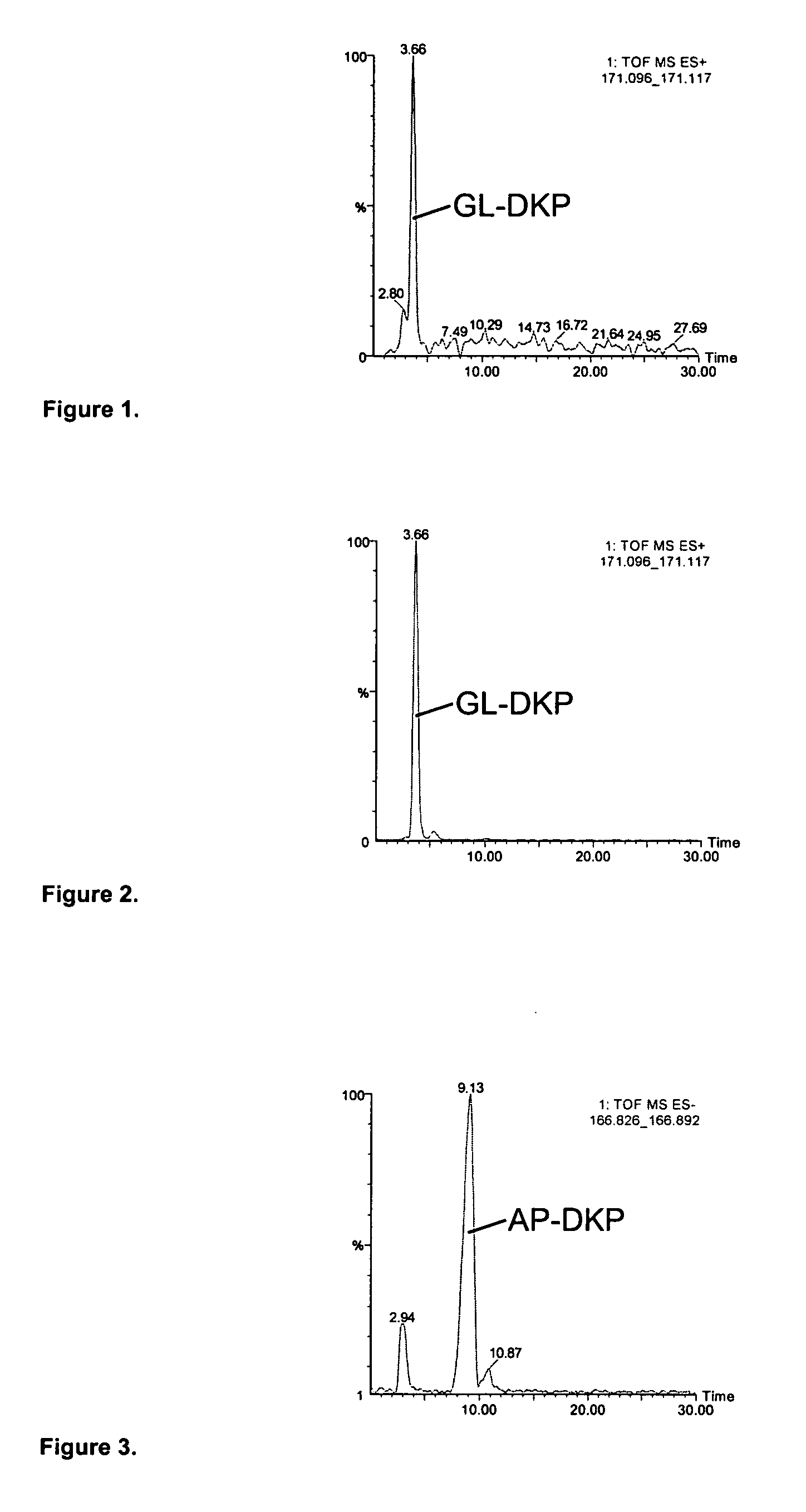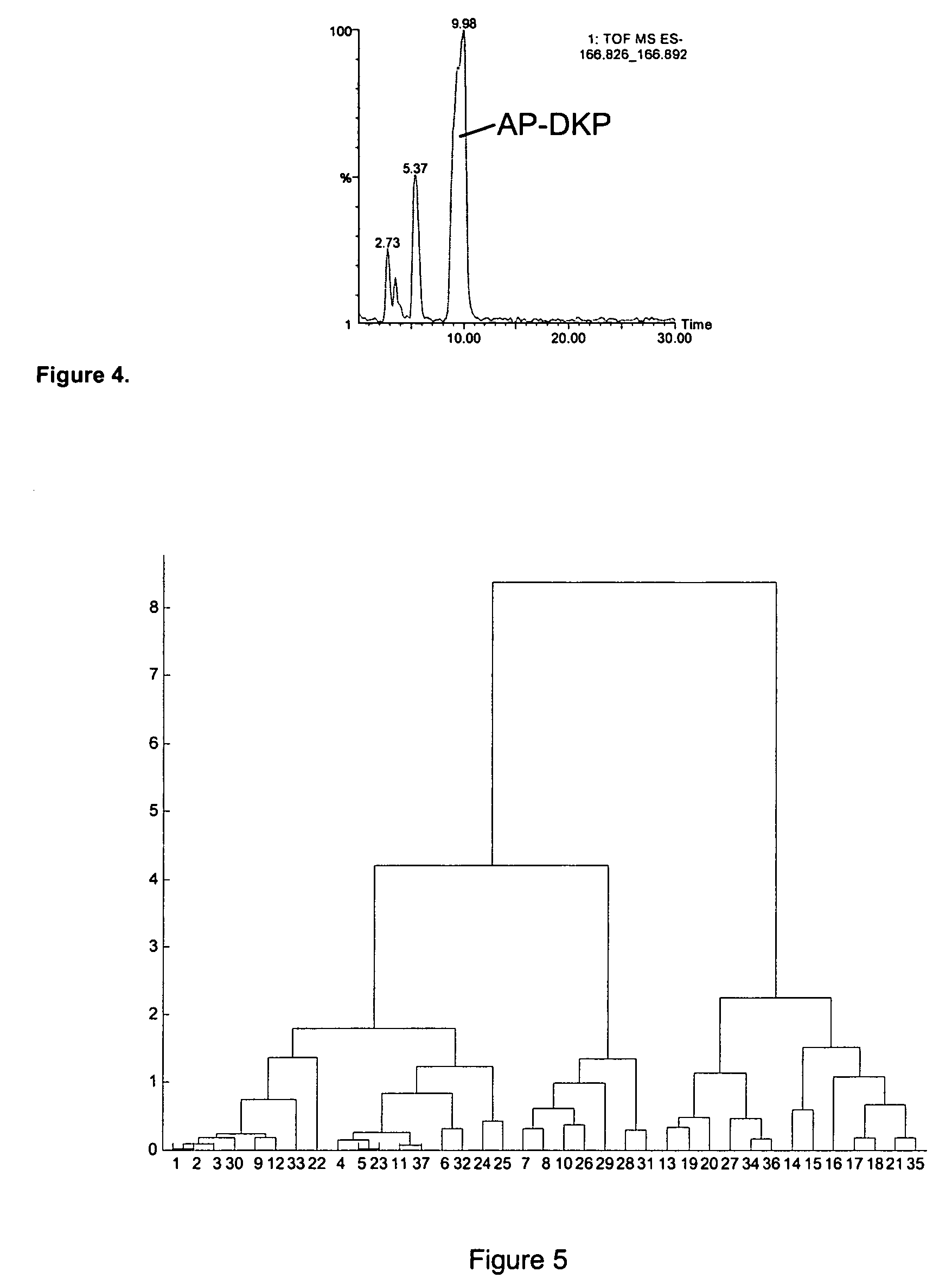Diagnosis of multiple sclerosis with diketopiperazines
a technology of diketopiperazine and multiple sclerosis, which is applied in the direction of biocide, instruments, peptide/protein ingredients, etc., can solve the problems of ms diagnosis, difficult diagnosis of multiple sclerosis (ms), and difficult diagnosis of ms, so as to achieve rapid and convenient measurement, effective treatment, and reliable diagnosis. easy and fast
- Summary
- Abstract
- Description
- Claims
- Application Information
AI Technical Summary
Benefits of technology
Problems solved by technology
Method used
Image
Examples
example 1
Diagnosis of Placental Ischemia
[0076]The presence of several diketopiperazines has been detected in maternal plasma. Of particular interest are the ones derived from the N-termini of β-human chorionic gonadotropin (βHCG) and fetal erythropoietin. These are glycine-leucine diketopiperazine (GL-DKP) and alanine-proline diketopiperazine (AP-DKP), respectively. AP-DKP, in particular, is elevated in FGR pregnancy due to elevation of fetal erythropoietin in FGR (Teramo, et al., Acta Obstet. Gynecol. Scand. 2002. 83(1): p. 245-51; Jazayeri et al., Am. J. Obstet. Gynecol., 2000. 183(1): p. 188-90; Jazayeri et al., J. Perinatol., 1999. 19(4): p. 255-9) and its specific degradation in acidic conditions (protonation of the N-terminal amino acid (Goolcharran and Borchardt, J. Pharm. Sci., 1998. 87(3): p. 283-8) and the relative importance for proline in position 2 of the primary amino acid sequence) to yield AP-DKP.
[0077]Subjects for the study were selected from patients referred to a Maternal-...
example 2
Classification of MS Patients Using Liquid Chromatography—Mass Spectrometry and Clustering
[0086]A novel method of determining the Multiple Sclerosis (MS) status of patients is presented here along with some results of a small test set of both MS and normal patients. In the present method, blood samples were collected from both normal and MS patients and analyzed by a liquid chromatography—mass spectrometry (LC-MS) method to determine the concentration of several putative MS markers. The resulting data were analyzed by a mathematical clustering technique that finds natural groupings within the data to see whether there were any simple relationships between the levels of these putative markers and the presence, absence or status of MS.
Patients
[0087]Patients with MS were diagnosed by accepted clinical and laboratory standards. Neurological signs and symptoms, magnetic resonance imaging evidence of demyelination, presence of oligoclonal bands in cerebrospinal fluid, white cell enumerati...
example 3
Analysis of an MS Patient Using Liquid Chromatography—Mass Spectrometry
[0101]A blood sample was collected from an MS patient with active MS and processed and analyzed by LC-MS as described in Example 2. The following DKP's were found: DA-DKP (from N-terminus of beta-amyloid), NAS-DKP (from N-terminus of myelin basic protein), N-acetyl-Ala Phospho-Ser DKP (from N-terminus of myelin basic protein), Gln-Asn DKP (from C-terminus of beta-amyloid) and Arg-Arg DKP (from C-terminus of myelin basic protein).
PUM
| Property | Measurement | Unit |
|---|---|---|
| Biological properties | aaaaa | aaaaa |
Abstract
Description
Claims
Application Information
 Login to View More
Login to View More - R&D
- Intellectual Property
- Life Sciences
- Materials
- Tech Scout
- Unparalleled Data Quality
- Higher Quality Content
- 60% Fewer Hallucinations
Browse by: Latest US Patents, China's latest patents, Technical Efficacy Thesaurus, Application Domain, Technology Topic, Popular Technical Reports.
© 2025 PatSnap. All rights reserved.Legal|Privacy policy|Modern Slavery Act Transparency Statement|Sitemap|About US| Contact US: help@patsnap.com


